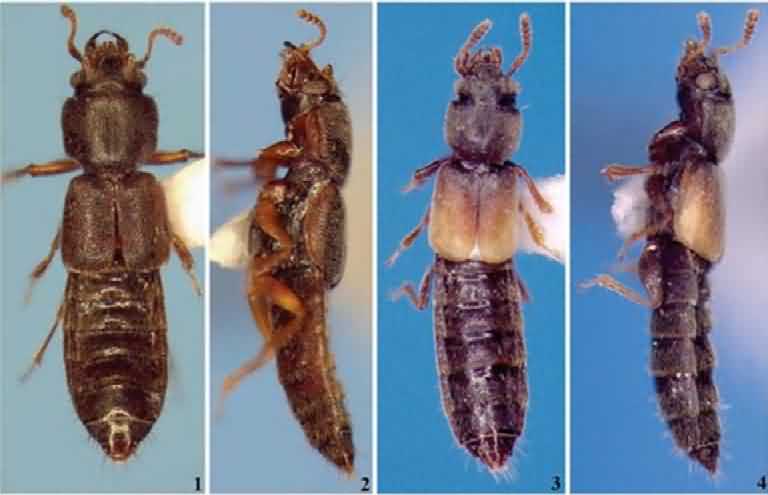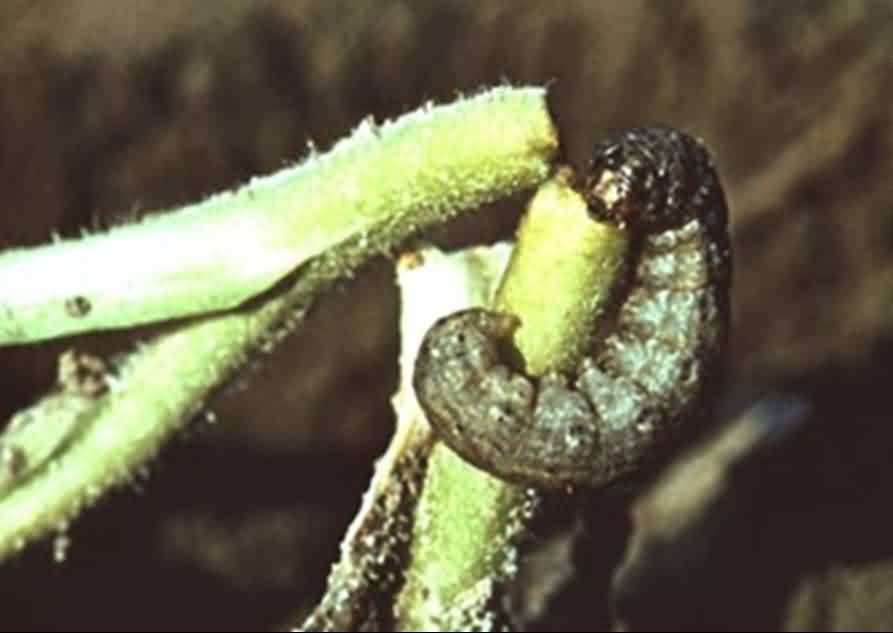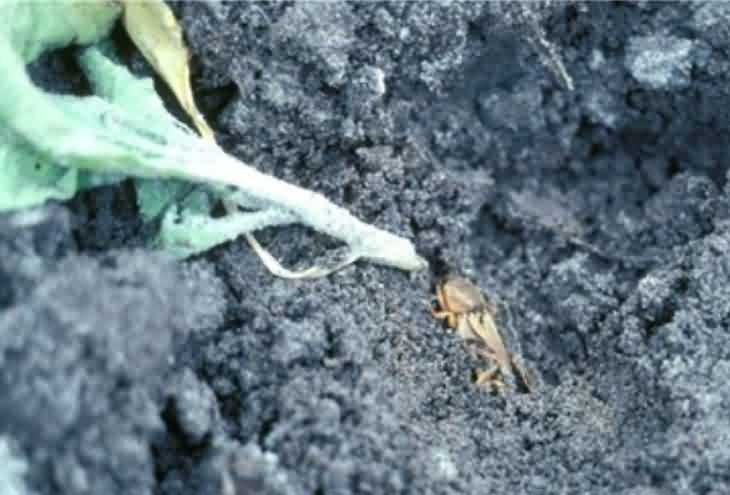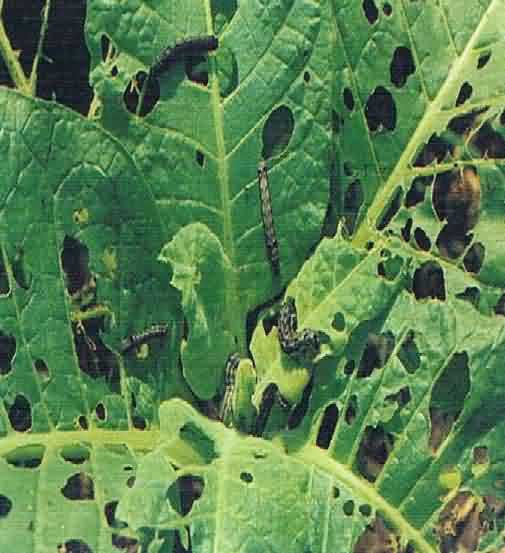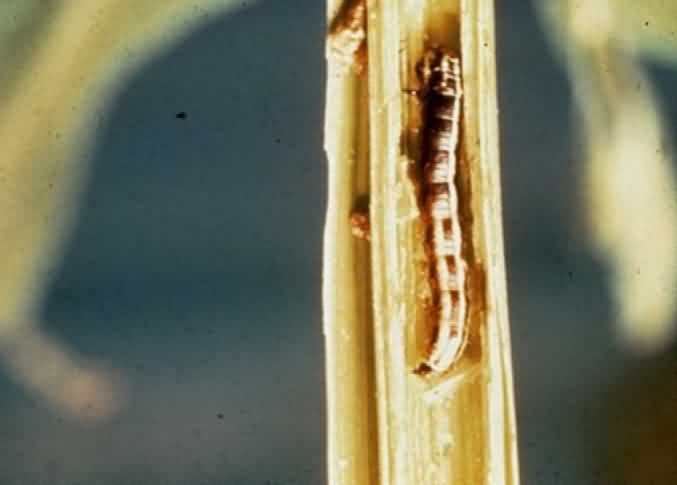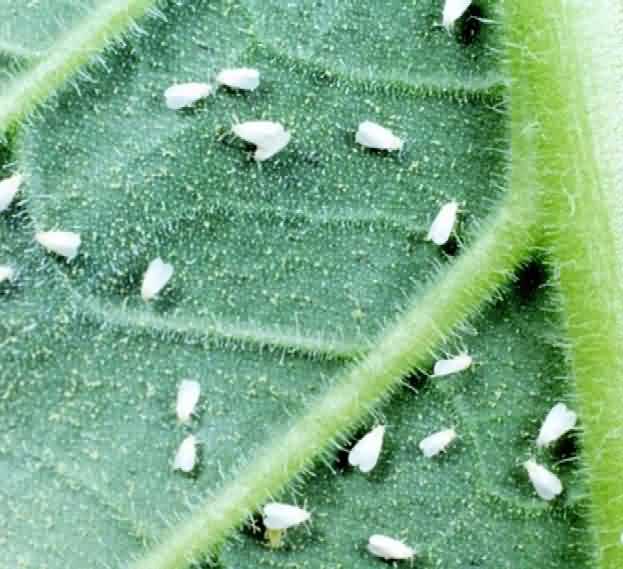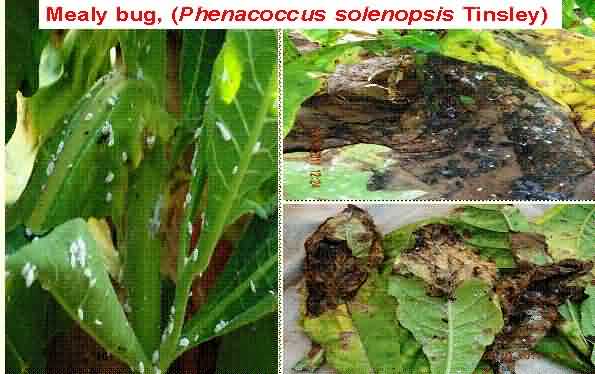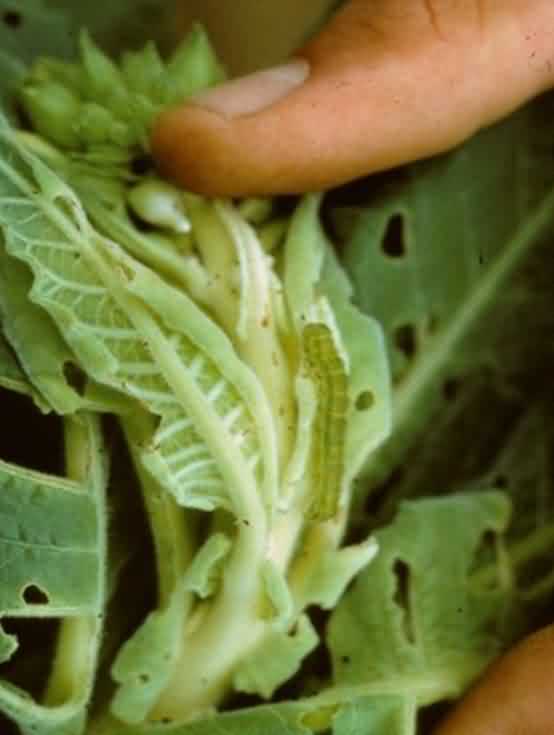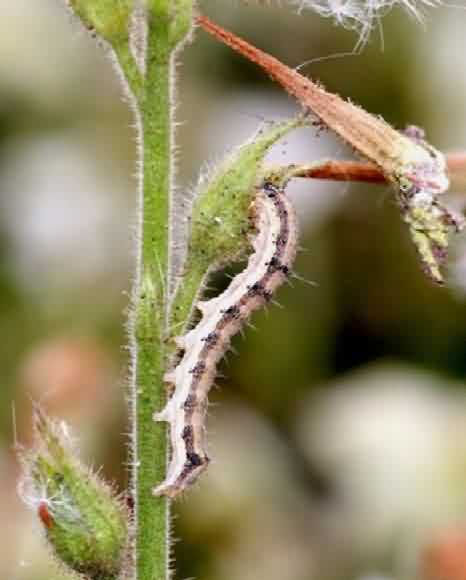तंबाकू की फसल में कीट पतंगों का प्रबंधन कैसे करें।
Tobacco is the most important cash crop in world’s agriculture and tobacco is cultivated in more than 100 countries on 4.2 million hectares. The genus Nicotiana embraces over 66 species only two species viz., Nicotiana tabacum L. and Nicotiana rustica L. are grown commercially in the world. India stands second in tobacco cultivation, production and exports in the world. In India, tobacco crop directly or indirectly supports 36 million people through production, processing, marketing and exports.
Tobacco is not only harmful but has many uses:
Alternate uses of tobacco:-
- Provide pesticides (Nicotine Sulphate and Tobacco dust)
- Pharmaceutical products for treatment of Alzheimer’s disease, Parkinson’s disease, Attention Deficit Disorder, Tourette’s syndrome, and Ulcerative Colitis
- Solenosol and its derivatives
- Nicotinamide and vitamin K
- Tobacco LEAF PROTEIN for food (About 300 qt green protein/ha)
- Tobacco SEED OIL
- Organic acids for industries and pharmaceutical use
- Tobacco based cosmetics and toiletries like deodorants.
I. Soil pests of Tobacco
1. Rove beetle (Bledius latiusculus Kraatz)
Beetle is a soil inhabiting pest. Very active in sandy and sandy loam soil. Beetles cause damage during germination of seeds in the nursery. They create characteristic burrows in soil, excavate soil particles, which cover tender seedlings and disturb the root system. The damage becomes more serious at each watering or when there is rain. The population of seedlings reduced up to 80 per cent.
Adult of Rove beetle (Bledius latiusculus Kraatz)
MANAGEMENT:
- Application of Beaurdex mixture (6:3:100) @ 4 l/1.2 m2 bed.
- Chlorpyriphos 0.05%
- Fenitrothion 0.05% and
- Quinalphos 0.05%
- Drenching of either Chlorpyriphos 0.04% or Endosulfan 0.07% @ 2 l / m2 one week after sowing.
- Application of Neem leaves extract @10% reduces the number of burrows/100cm2 and provide maximum number of transplantable seedlings/2.2 m2.
2. Tobacco cutworm (Agrotis ipsilon Hufnagel)
Caterpillar cuts the stalk of seedlings as well as transplanted plants at ground level. They feed only at night and may be found in the day time either just below soil level or under leaves.
Tobacco cutworm (Agrotis ipsilon Hufnagel)
MANAGEMENT:-
- Application of Endosulfan 4% dust @ 25 kg/ha on soil.
- Endosulfan dust @ 1.25 kg a.i./ha as soil application around the plant base at 15 and 35 days after transplanting. Or
- Two application of Chlorpyriphos @ 0.16 kg a.i./ha,
- Endosulfan @ 0.28 kg a.i./ha and
- Monocrotophos 0.24 kg a.i./ha as foliar spray were found effective against cutworm in cigar wrapper tobacco field.
- Carbaryl 5% @ 25 kg/ha is superior in tobacco field condition.
3. Mole cricket (Gryllotalpa africana Palisot de Beauvois)
Feed on roots and near ground plant parts. Main harm is through physical damage to seedbeds. Burrows are created under the surface at night when come for feed which uproot germinating seedlings. Preference for damp conditions makes seedbed areas attractive.
Mole cricket, (Gryllotalpa africana Palisot de Beauvois)
Control:
- Drenching of Chlorpyriphos 0.04% and Endosulfan 0.07%.
II. Above ground pests of tobacco
1. Tobacco leaf eating caterpillar (Spodoptera litura Fabricious)
Worst enemy of tobacco nurseries. They cut the seedlings. They voraciously feed on the leaves. Entire seedbeds defoliated within a week. The pest causes damage to an extent of 80-100% in the nurseries and 10-25% in the field crop.
Damage of S. litura in nursery Damage of S. litura in field crop
Control Measures:
- Ploughing in summer.
- Collection and destruction of egg masses.
- Clipping of leaves having swarms of tiny larvae.
- Fenvalerate 0.02% gave quick mortality of S. litura in the tobacco field
- Application of Carbaryl 0.1 in field.
- Sprays of Neem Seed Kernel Suspension @ 2% (NSKS 2%) in nursery.
- Adoption of Integrated Pest Management approaches which increases the cured leaf yield kg/ha.
- Application of Bt formulations (Biolep and Bioasp @ 2 kg/ha) reduces the seedlings as well as leaves damage by the Spodoptera litura in tobacco nurseries.
- Use Monocrotophos and Clorpyriphos baits for Spodoptera litura.
- Application of Methofenozide 0.01% in nursery.
- Spraying of Entomophage nematode (Steinernema carpocapsae) infective juvenile’s formulation reduces the 3rd, 4th and 5th instar larvae of S. litura.
2. Tobacco stem borer, (Scrobipalpa heliopa Lower)
Tiny caterpillars of the stem borer bore inside the stem and mid ribs. They feed on internal tissues hence swelling appears outside where the borer stays. It causes stunting and unusual branching of the seedlings. The transplanted crop also affected cause economical loss up to 25 per cent.
Tobacco stem borer, (Scrobipalpa heliopa Lower)
Management:-
- Application of carbaryl 0.15% at an interval of 15 days.
- Quinalphos 0.05% and Cypermethrin 0.0125% toxic to eggs and quinalphos 0.05% to the first instar larvae on rustica tobacco.
- Cypermethrin 0.0125% and quinalphos 0.05% gave cent per cent mortality of eggs of S. heliopa.
- Application of phenthoate 0.05%, fenvalerate 0.01% and triazophos 0.06% caused more than 80% egg mortality.
- Remove and destruct the stubbles after harvesting of crop which avoids carry over of infestation in next season.
- Chelonus heliopae parasitizes the stem borer larvae to 3.72 to 49.6%.
3. Whitefly (Bemasia tabaci Gennadius)
Seen on the underside of leaves. They will fly immediately when the plant is disturbed. The adult fly sucks the sap from leaves. Transmits the leaf curl virus diseases from infected to healthy seedlings.
Whitefly (Bemasia tabaci Gennadius)
Management:-
- Removal and destruction of curled plants and alternate hosts.
- Apply Dimethoate 0.045% or Methyl-s-demeton 0.0375% or Monocrotophos 0.06% and Flucythrinate 0.005% at 15 days interval in nurseries starting from 30 days after seeding and in field crop, 2 to 3 sprays of the same insecticides at 10 days interval commencing from 15 days after planting.
- Growing of barrier crops such as Jowar, Bajara, Dainch, Maiza and Tobacco as a sole crop around the main field reduces the whitefly incidence.
4. Aphid (Myzus persicae Sulzer)
Sucks the sap and make the plants pale, sickly and retards growth. Growth of black sooty mould develops on leaves makes them unfit for curing. If cured the quality of leaf gets reduced considerably.
Management:-
- Grow Jowar as a barrier crop reduces the aphid population.
- Spraying of Methomyl, Monocrotophos, Triazophos and Profenophos reduces the aphid incidence in field as well as in nursery.
5. Mealy bug, (Phenacoccus solenopsis Tinsley)
Nymph and adult feed on phloem and excrete honey dew which encourages the development of sooty mould that reduces plant photosynthetic abilities which ruins the plant’s appearance makes the leaves unfit for curing.
Management:-
- Clean cultivation and burn the residues or weed host plant around the main field.
- Grow barrier crop such as sorghum and bajra prevent the further spreading the mealy bug population.
- Biological control such as ladybird beetles, Aenasiusbambawale, Chrysoperla carnia etc.
- Spraying of Carbaryl 0.02%, Prophenophos 0.1% and Methomy 0.08% reduces the mealy bugs and enhance the yield of tobacco.
6. Tobacco budworm/capsule borer (Helicoverpa armigera Hubner)
Caterpillars bore the bud as well as capsule and destroy the seeds. Under the severe infestation they feed on leaves also.
Tobacco budworm/capsule borer (Helicoverpa armigera Hubner)
Management:-
- Spraying of HaNPV (7.5 X 1012) reduces the per cent capsules damage per plant.
- Spray Indoxacarb 150 SC control the H. armigera larvae.
- Chemosterilant Tepa 0.05% and Thiotepa 0.05% induce cent per cent sterility.
- Hempa - induces 68 per cent sterility in male.
- Decamethrin 0.025% found effective against H. armigera on bidi tobacco.
- Fenvalerate 0.4% dust @ 1 kg a.i./ha in reduction of damage caused by H. armigera in tobacco.
- Application of indoxacarb, methomyl and chlorpyriphos @ 100, 400 and 500 ml per 100 lit of water found effective.
III. Pests of stored tobacco
1. Cigarette beetle, (Lasioderma serricorone Fabricius)
Larvae feed on the leaves making large galleries. When the infestation is heavy turn the leaf into powder that deteriorate its quality which affects price of the product.
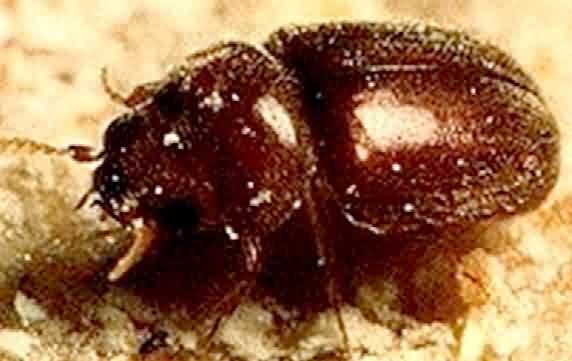
Cigarette beetle, (Lasioderma serricorone Fabricius)
Control Measures:-
Keep the premises very clean by removing and destroying waste tobacco pieces and dust.
The Godown should be Free of cracks and crevices and properly white washed.
Well lighted with double doors windows and ventilators.
Screened with wire mesh (20 meshes to 2.54 cm) to prevent entry of beetle from outside.
Tobacco should be store at low temperatures (15 to 18° C).
The twenty tablets of 3g of Aluminium phosphide per 1000 cubic feet with 96 hours exposure kill all the stages of the beetle.
Use of Tobacco in Pest Management
Nicotine is the principal tobacco constituent having insecticidal property. No insect has ever developed immunity to this chemical and it biodegrades rapidly and has no residual effect. The biological evaluation of Nicotine Sulphate against various insect pests attacking different crops and cotton pests is very important. It caused quick knockdown effect against brown plant hopper (Nilaparvata lugens Stal.).
The mortality of this pest was up to 97 to 100% within 30 and 60 minutes, respectively and the same level of mortality was observed in paddy green leaf hoppers (Nephotettix spp.). Significant efficacy of nicotine sulphate at 0.05% against safflower aphid (Euroleucon compositae Theeh) is also obsrved. Among the vegetable pests, grubs of Epilachna beetle (Henosepilachna vigintioctopunctata F.) on egg plant, diamond back moth (Plutella xylostella L.) on cauliflower and Aphis gossypii Glover on tomato was controlled effectively with application of nicotine sulphate at 0.2%. Tobacco decoction at 2.5% against B. tabaci recorded 100% mortality in 96 h.
Tobacco has been also used as a bird repellent against rose ringed parakeet, Psittacula krameri through application of tobacco leaf powder decoction (10%) on sorghum ear head.
Authors:
Babu Lal Jat and D. M. Mehta1
Department of Entomology, College of Agriculture,
CCS Haryana Agricultural University, Hisar, Haryana, 125 004
Email:
1Research Scientist, Bidi Tobacco Research Station,
Anand Agricultural University, Anand 388 110

